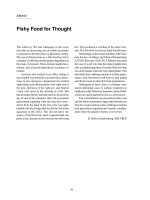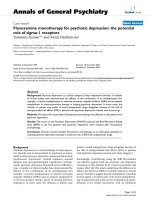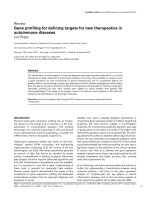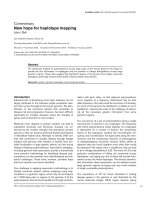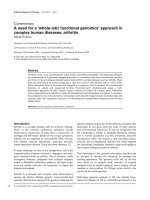Báo cáo y học: " Engendering enthusiasm for sustainable disaster critical care response: why this is of consequence to critical care professionals" pps
Bạn đang xem bản rút gọn của tài liệu. Xem và tải ngay bản đầy đủ của tài liệu tại đây (41.29 KB, 3 trang )
125
ICU = intensive care unit.
Available online />Abstract
Disaster medical response has historically focused on the pre-
hospital and initial treatment needs of casualties. In particular, the
critical care component of many disaster response plans is
incomplete. Equally important, routinely available critical care
resources are almost always insufficient to respond to disasters that
generate anything beyond a ‘modest’ casualty stream. Large-scale
monetary funding to effectively remedy these shortfalls is
unavailable. Education, training, and improved planning are our most
effective initial steps. We suggest several areas for further develop-
ment, including dual usage of resources that may specifically
augment critical care disaster medical capabilities over time.
Disasters have been a part of human existence since ancient
times, and so has disaster medicine [1]. We define disaster
medicine as a human response to unexpected mayhem, with
the intent to limit death, disease, and injury. In recent decades,
disaster medical response has largely focused on prehospital
care issues such as casualty evacuation, triage, and transport,
without specific emphasis on hospital management. In the
United States, this phenomenon is referred to as ‘ambulances
to nowhere’. Recent experiences with large-scale disasters
have strongly reinforced the fact that hospital capacity is the
major rate-limiting factor in the chain of medical response. This
is especially true for critical care services and intensive care
unit (ICU) bed capacity [2]. As we continue working to build
adequate disaster medical response systems we must
maintain our prehospital readiness efforts, and we must
expand our focus to more precisely define the hospital and the
ICU as critical links in the entire response process. The
purpose of the present commentary is to explore ways in
which this expansion of focus might be conceived.
A number of recent examples illustrate the importance of the
hospital and the ICU in the medical response to disaster.
Within a few hours of the Madrid bombing explosions in
March 2004, 27 critically ill patients were admitted to the two
closest hospitals, which had a maximum ICU capacity of
28 beds, most of which were already occupied [3]. After the
terrorist bombing in Bali, the Royal Darwin Hospital in
Australia, with a capacity to care for a maximum of
12 ventilated patients, was presented with 20 critically ill
patients, 15 of whom required mechanical ventilation [4].
Flooding due to heavy rain in June 2001 crippled the Texas
Medical Center in Houston, and resulted in a sudden loss of
75% of the ICU bed capacity for a county of 4 million people
[5]. And it is not just ICU bed capacity that is subject to being
overwhelmed. Damage to the physical and organizational
structure of the hospital may wipe out an entire critical care
infrastructure. Some disasters may harm healthcare workers,
thus limiting available ICU personnel. This was the case
during the Tokyo Sarin gas subway attack in 1995, and more
recently during the severe acute respiratory syndrome
outbreak in Canada and Asia [6].
Viewed in the context of the everyday strain on our currently
available resources, the challenge is even greater [7]. An
analysis of the capacity of a 1200-bed hospital in the United
States to handle patients in the setting of a toxic chemical
exposure event revealed an ability to handle only two
chemically contaminated patients at a time [8]. Add to this
the fact that in many countries, because of efficiency and
budgetary constraints, hospitals are shrinking in capacity.
This has resulted in hospitals working at or near maximum
capacity every day, with associated logistical concerns such
as overcrowding, diversion of ambulance services, and lack
of surge capacity. Particularly important is the inability of
emergency departments to move critically ill patients to their
inpatient setting [9] due to the unavailability of staffed critical
care beds. With future projections for a shortage of critical
care physicians [10] and critical care nurses [11,12], these
logistical barriers to ICU care will persist [13] and will
influence the provision of disaster critical care response.
Commentary
Engendering enthusiasm for sustainable disaster critical care
response: why this is of consequence to critical care professionals?
Saqib I Dara
1
, Rendell W Ashton
2
and J Christopher Farmer
3
1
Critical Care Medicine fellow, Division of Pulmonary and Critical Care Medicine, Mayo Clinic, Rochester, Minnesota, USA
2
Pulmonary and Critical Care Medicine fellow, Division of Pulmonary and Critical Care Medicine, Mayo Clinic, Rochester, Minnesota, USA
3
Consultant in Critical Care Medicine and Professor of Medicine, Division of Pulmonary and Critical Care Medicine, and the Program in Translational
Immunovirology and Biodefense, Mayo Clinic, Rochester, Minnesota, USA
Corresponding author: J Christopher Farmer,
Published online: 27 January 2005 Critical Care 2005, 9:125-127 (DOI 10.1186/cc3048)
This article is online at />© 2005 BioMed Central Ltd
126
Critical Care April 2005 Vol 9 No 2 Dara et al.
Taken together, this means that we do not need a major
disaster like a terrorist attack or an emerging infectious
disease epidemic to tip the strained balance between the
supply and demand of critical care resources. Disasters of a
local scale alone can tip the balance, such as when a fire
broke out at a nightclub in Rhode Island in 2003. The local
hospital immediately received 40 critically-ill patients, most
requiring intensive care support [14].
Education and training are effective modalities that tangibly
enhance disaster medical response at every level. However,
current disaster medical education programs for healthcare
professionals are not coordinated in scope and content, and
may not address the most pressing needs for critical care
personnel. What are the imperatives that must be taught? For
example, it would be an error to assume that principles of
triage, recognition of smallpox, antibiotics for anthrax, proper
dosing of atropine, and so forth, represent a sufficient
knowledge base. The severe acute respiratory syndrome
outbreak of 2003 emphatically demonstrated that scrupulous
training and execution of infection control practices became a
survival skill for ICU personnel. Unfortunately, this is not
substantially represented in our current disaster medical
education programs.
Does this mean we need to build more beds, hire additional
specialized personnel, or stockpile antibiotics, antidotes, and
equipment against a possible disaster situation? We think
not; this would be unworkably expensive and would still leave
us incompletely prepared for many of the disaster scenarios
just described. So, what are the solutions? We offer the
following suggestions in order of priority. These concepts
attempt to build on existing resources. We do not pretend to
offer evidence-based guidelines. Rather, our intention is to
engender discussion and dialog.
Education and training
Pre-emptive education is the single most effective tool we can
employ to mitigate the future effects of a disaster. In terms of
impact, the education of healthcare professionals is at the top
of the list [15]. The educational initiatives we propose to
accomplish this goal are as follows: heightened disaster
response awareness, enhanced skill sets, understanding of
roles and responsibilities, alternate communication methods,
self-preservation training, and experience in how to cooperate
and coordinate during mayhem.
Medical preparedness training should not be limited to first-
line treatment, but must include targeted training that
covers the entire disaster medical spectrum [16]. The
challenge is distilling all of this into a curriculum that fits the
very limited time availability of healthcare professionals. As
one evolving example, the Society of Critical Care Medicine
has developed a standardized and highly concentrated
course (Fundamentals of Disaster Management) to equip
critical care professionals with basic but essential disaster
medical knowledge. The content of this program is still in
evolution.
Disaster response medical simulation approximating actual
scenarios enables disaster planners and responders to test
procedures and technologies, and to incorporate the lessons
learned from past disasters [17]. This simulation has been
shown to be effective [16,18]. The level of realism is much
higher than in facility-based exercises, where time and
personnel utilization are compressed and usually do not
adequately teach disaster resource management.
Finally, there is a useful role for what is termed ‘just-in-time
training’. The intent of these programs is to make concise
knowledge available to providers, at the time of an event and
at the point of care. Most of these are Web-based knowledge
collections that can be queried. This approach is less time
intensive, less labor intensive, and less cost intensive than
traditional educational processes. We should point out,
however, that ‘just-in-time training’ serves as an adjunct, but
alone it is not an adequate replacement for the other methods
enumerated here. Any ‘just-in-time training’ program is only as
effective as the skills of the professional in accessing the
training when it is needed, which must be in place beforehand.
Interfacility cooperation
Experience has shown that the burden of disaster medical
response largely falls to healthcare facilities proximate to an
event. Despite the widely held impression that ‘the
government will be there’, outside help and intervention
typically does not have a large impact on the initial phases of
disaster medical response. We have already outlined some of
the obstacles, such as strained resources or lack of
communication and training, that impede cooperation. While
most hospitals have plans for response to local disasters
mapped out, plans that looked good on paper often go awry
during execution [19]. In terms of interfacility cooperation,
given that many local hospitals financially compete with each
other, teamwork in the event of a disaster is expected to
materialize where it has not been previously encouraged. As
such, the results are seldom efficient.
A rational approach to tackle this issue includes the
development of flexible and scalable plans for interchanging
resources to augment the existing capacity of individual
hospitals [20]. For example, many communities currently
divide disaster responsibilities according to the type and
severity of injuries among the various hospitals. Unfortunately,
a significant percentage of casualties make their own way to
the hospital, irrespective of these plans. A better way would
be to build flexible surge capacity that allows hospital
personnel to move from one facility to another according to
need. Such adaptation to circumstances will not happen
spontaneously, and will require significant pre-planning. An
additional example of efficient sharing is disaster medical
education; many or all of the educational proposals outlined
127
in the previous section could be shared, increasing
availability, cost-effectiveness and, probably, quality.
Dual usage of resources
As we have suggested, the cost of effective disaster planning
is enormous. It is not realistic to expect budget-constrained
facilities to absorb these additional costs, and yet relief from
governments will not fill the gap. It therefore seems
reasonable to seek economies of scale, such as dual-use
modalities. For example, to increase ICU surge capacity,
consider our ability to provide critical care outside of a
designated geographical location. A significant volume of
critical care is provided (nondeliberately) every day outside
the geographical constraints of an ICU, hence the growing
development of medical emergency teams in hospitals
around the world [21]. With little additional training, these
teams could provide a highly effective adjunctive capability
during disaster medical response when critical care units are
full but additional ICU services are required.
As a second example, ensuring patient safety in the hospital is
also emerging as a significant resource-consuming, but
essential, activity [22]. This is especially true as we move
beyond compliance activities into multidisciplinary, tiered
accident and error prevention. From this perspective, a medical
catastrophe may encompass a single patient who receives
improper medication through to mass casualty circumstances.
While these events are fundamentally different in scope,
magnitude, and cause, they share at their core a need for
accurate and complete planning and education to prevent or
mitigate their consequences. Is there sufficient overlap to
merge some of the planning, education, and practice of
hospital patient safety and disaster medical response?
In summary, where we have been will not get us to where we
need to go for disaster critical care response. First, we must
work around apathy, confusion of purpose, and a lack of
monetary resources to widen the spotlight of disaster medical
response from the prehospital arena to include the hospital.
We must enhance our abilities and capacity across the whole
spectrum of disaster medical response.
These efforts are the responsibility of society as a whole. All
involved organizations including hospitals, emergency
medical services, fire services, police, the public health
system, local municipalities and government authorities, and
other health care institutions will need to integrate into a well-
developed disaster educational system and response team
[23]. In the present article we have attempted to outline
conceptual elements that may facilitate some of this
integration. For this to happen, someone with comprehensive
understanding and the necessary expertise is required
nationally, regionally, and locally to provide the leadership
imperative that drives integration of these disparate entities
and resources. The first step is ownership, and as critical
care professionals we are obliged to step forward and
provide the leadership for these processes.
Competing interests
The author(s) declare that they have no competing interests.
References
1. Dara SI, Ashton RW, Farmer JC, Carlton PK, Jr: Worldwide dis-
aster medical response: a historical perspective. Crit Care
Med 2005, 33:S2-S6.
2. Grissom TE, Farmer JC: The provision of sophisticated critical
care beyond the hopital: lessons from physiology and military
experiences that apply to civil disaster medical response. Crit
Care Med 2005, 33:S13-S21.
3. de Ceballos JPG, Turégano-Fuentes F, Perez-Diaz D, Sanz-
Sanchez M, Martin-Llorente C, Guerrero-Sanz JE: 11 March
2004: the terrorist bomb explosions in Madrid, Spain — an
analysis of the logistics, injuries sustained and clinical man-
agement of casualties treated at the closest hospital. Crit
Care 2005, 9:104-111.
4. Palmer DJ, Stephens D, Fisher DA, Spain B, Read DJ, Notaras L:
The Bali bombing: the Royal Darwin Hospital response. Med J
Aust 2003, 179:358-361.
5. Sincell M: Natural disasters. Texas Medical Center staggered
by deadly tropical storm [news]. Science 2001, 292:2226.
6. Booth CM, Stewart TE: Communication in the Toronto critical
care community: important lessons learned during SARS. Crit
Care 2003, 7:405-406.
7. Wetter DC, Daniell WE, Treser CD: Hospital preparedness for
victims of chemical or biological terrorism. Am J Public Health
2001, 91:710-716.
8. Noji EK: Creating a health care agenda for the Department of
Homeland Security. Managed Care 2003, 12:7-12.
9. Church A: Critical care and emergency medicine. Crit Care
Clin 2003, 19:271-278.
10. Angus DC, Kelley MA, Schmitz RJ, White A, Popovich J, Jr:
Caring for the critically ill patient. Current and projected work-
force requirements for care of the critically ill and patients
with pulmonary disease: can we meet the requirements of an
aging population? JAMA 2000, 284:2762-2770.
11. Steinbrook R: Nursing in the crossfire. N Engl J Med 2002, 346:
1757-1766.
12. Buerhaus PI, Staiger DO, Auerbach DI: Implications of an aging
registered nurse workforce. JAMA 2000, 283:2948-2954.
13. Karwa M, Bronzert P, Kvetan V: Bioterrorism and critical care.
Crit Care Clin 2003, 19:279-313.
14. Dacey MJ: Tragedy and response — the Rhode Island night-
club fire. N Engl J Med 2003, 349:1990-1992.
15. Eitzen EM, Jr: Education is the key to defense against bioter-
rorism. Ann Emerg Med 1999, 34:221-223.
16. Vardi A, Levin I, Berkenstadt H, Hourvitz A, Eisenkraft A, Cohen A,
Ziv A: Simulation-based training of medical teams to manage
chemical warfare casualties. Isr Med Assoc J 2002, 4:540-544.
17. Simmons SC, Murphy TA, Blanarovich A, Workman FT, Rosenthal
DA, Carbone M: Telehealth technologies and applications for
terrorism response: a report of the 2002 coastal North Car-
olina domestic preparedness training exercise. J Am Med
Inform Assoc 2003, 10:166-176.
18. Berkenstadt H, Ziv A, Barsuk D, Levine I, Cohen A, Vardi A: The
use of advanced simulation in the training of anesthesiolo-
gists to treat chemical warfare casualties. Anesth Analg 2003,
96:1739-1742.
19. Auf der Heide E: Disaster Response: Principles of Preparation
and Coordination. St Louis, MO: Mosby; 1989.
20. Hick JL, Hanfling D, Burstein JL, DeAtley C, Barbisch D, Bogdan
GM, Cantrill S: Health care facility and community strategies for
patient care surge capacity. Ann Emerg Med 2004, 44:253-261.
21. Buist MD, Moore GE, Bernard SA, Waxman BP, Anderson JN,
Nguyen TV: Effects of a medical emergency team on reduction
of incidence of and mortality from unexpected cardiac arrests
in hospital: preliminary study. Br Med J 2002, 324:387-390.
22. Institute of Medicine: To Err is Human: Building a Safer Health
System. Washington: The National Academies Press; 2001.
23. The Joint Commission for Accreditation of Health Care Organiza-
tions: Health Care at the Crossroads: Strategies for Creating and
Sustaining Community-wide Emergency Preparedness Systems.
Oakbrook Terrace, IL: JCAHO Press; 2003.
Available online />





